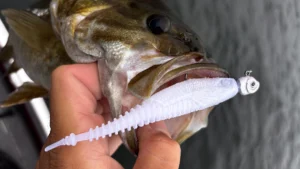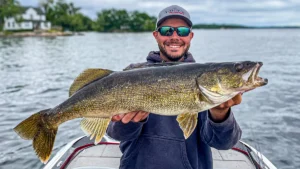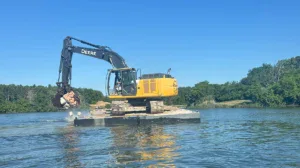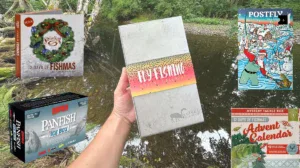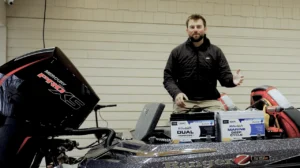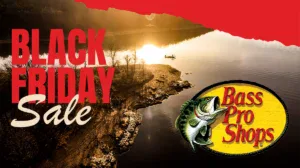Crawler harness or spinner rigs for walleyes have been around for as long as cars have been painted black. Regardless of what you call them, they consistently put fish in the boat shortly after ice out and continue to through summer’s boiling temperatures. Understanding the variables will help you select the proper material, style and finish much more efficiently to help your walleye fishing.
MATERIAL
Much like selecting screws and bolts at the hardware store, you first need to understand and decide what blank material you want or is best for the given situation. Most quality spinner blades are stamped from brass and have a plated and or painted finish over the top.
“Brass is easier to polish, doesn’t rust, has a more brilliant finish and can be stamped in more shapes due to its soft nature,” said Silver Streak designer and owner Chip Cartwright. “Brass is what we stamp our spoons and walleye blades out of almost exclusively.”
Steel is another material that blades are offered in. Not as popular as brass for the reasons mentioned above, they are much less expensive and frequented used by serious anglers at times due to the different vibration they offer.
Another revamped material is plastic. As a kid, my dad would swear by plastic-bladed spinner rigs that were older than us both together. After losing his last one more than a decade ago they are now available again from Dutch Fork Tackle. Much lighter than brass or steel they offer a different vibration and a plethora of color options with their clear design.
SHAPE
The preferred style of spinner blade can depend on the water clarity, depth and speed you plan to drift or troll. Many anglers get stuck using just one or two of the most popular choices, but many other harder to find styles offer a different look fish seldom, if ever, see.
Colorado
Easily the most popular choice of spinner blade for their combination of both flash and vibration. Larger sizes are very popular in off-colored to dirty water and used at a wide array of speeds, but usually not exceeding 2 mph. Many manufactures offer them in a deep cup design that helps them spin at slower speeds as well as provide more vibration.
Indiana
Not as main stream or readily available as it was many years, it is just as effective if not more so. Offering more flash and a little less vibration than a Colorado blade, the Indiana is somewhat unique in that the larger sizes appear almost as a different shape. This can be seen with the No. 5, 6 and 8 pictured.
Willow
In the past few years, the popularity of these blades has sky rocketed on large bodies of water such as the Great Lakes. With very little vibration in their stream line shape, they instead rely on the flash that they put off. This make them ideal in clean water and when trolling at speeds on the higher end of the spectrum.
Chopper
Easily the most unknown and difficult to find blade on the list. Chopper blades offer a unique balance of flash and vibration thanks to the narrow top end and deep cup bottom. As sizes get larger they don’t get proportionately larger as much as they do wider.
Hatchet/Doc Sheldon
Another underutilized shape, these appropriately names blades look like a hatchet. A similar style blade called a Doc Sheldon offers many of the same attributes but with a slightly more rounded design. Fans of hatchet blades all seem to have different scenarios in which they feel they work best, having them on a rod and in the water seems to be the most important factors since they work from the top to bottom of the water column.
Mag Willow
The best way to describe a mag willow over the phone I have found is to call it an “overweight willow”. These wider versions of a traditional willow blade work really well when you need to troll or drift at faster speeds but desire a little more vibration. On larger lakes when fishing deep at speeds over 1.5mph a mag willow is perfect fitting blade that many of those fish have not seen.
FINISH
Having the best style blade for the conditions is very important, but color of spinner blades seems to matter as much or more when compared with other presentations.
Fluorescent
Years ago, Bill Binkelman helped enlighten us to the effects of fluorescent paint in fishing. A majority of lure manufactures use fluorescent paint in order to have a wide array of color options and more under water visibility.
UV
A more recent craze that has been the buzz of paint finishes the last few years. The fact that fish and birds have an extra cone in their eye that allows them to see farther into the spectrum. UV can be as much as 200 times brighter to fish when compared to glow paint and visible to 400 feet.
Antifreeze
A very popular trend on lakes with cleaner water. Most are painted with lacquer over a silver plated blank to give a see through color look. In waters that are slightly off colored having opaque edges or dots on them have proven to be very productive.
Metallic
Very popular under most water conditions because they offer color with a bit of flash mixed in. Many anglers simply prefer a silver, gold or copper plated finish to provide the most amount of flash possible.
Hammered
Finishes can drastically effect how much flash is thrown off of the blade. While a rounded hammered or dimple finish has been a staple for years, many other finishes are now readily available. Finishes such as “cheese grader, honeycomb or slasher” offer something just a little different for your presentation.
Back Colors
For years manufactures painted the front of the blades with fancy finishes and had a plain metallic or plated back on them. Only the simple and solid colors had a painted back and they almost always were the same color as the front. Many believe that their success is because of the contrast that they provide as the blades spin.
There are a lot of factors to consider when choosing a spinner blade for walleyes. While some styles are best because of their effective speed range, others just seem to work because fish on different bodies of water all seem to have varied preferences for both style and color. Don’t be afraid to step out of your comfort zone and try a style or finish out of the ordinary.








